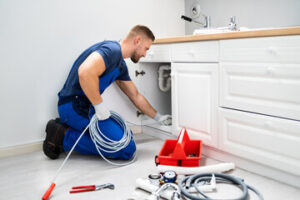Pro Plumbing Orillia is the system of pipes and fixtures that bring fresh water into buildings and remove waste. It is regulated by both federal and state governments, as well as by the International Plumbing Code (IPC). Plumbers install, repair, and maintain these systems, ensuring that they meet health and safety standards.

Plumbing involves the installation and maintenance of pipes, fixtures, and appliances that facilitate water supply, drainage, and waste management. This essential service ensures clean drinking water and the safe removal of wastewater, promoting health and safety in residential and commercial buildings. Plumbers work on a wide range of projects, including repairing broken drains, leaky faucets, and water heaters. They also inspect and maintain piping systems to identify problems before they become serious.
Plumbers use a variety of tools and materials to install, repair, and maintain plumbing systems. Some of the most common tools include adjustable wrenches, pipe cutters, pliers, hacksaws, and teflon tape. Plumbers also use specialized tools for unclogging drains and pipes. These include augers and snakes, which can be used to remove stubborn clogs. They also use hydro jets, which are powerful pumps that can clear out blocked sewer lines.
In addition to installing and repairing plumbing fixtures, plumbers also inspect their work to ensure compliance with building codes and standards. They may also offer advice and recommendations on how to improve the performance of plumbing systems. They often collaborate with other professionals, such as engineers and architects, to ensure that plumbing systems are integrated seamlessly into construction projects.
Plumbing is a complex and vital system that impacts the health and safety of occupants in residential and commercial buildings. Properly installed and maintained plumbing systems prevent water contamination, backflow, and structural damage. However, poor-quality plumbing can lead to mold growth, bacterial growth, and other health hazards. In addition, sewage backups can pose serious health risks and should be addressed promptly. Regular inspections and timely repairs help prevent these issues, saving occupants money, time, and stress.
It is regulated by federal and state governments
Plumbing is a complex system that carries water, waste, and other materials throughout a building. It requires a high level of technical knowledge, and plumbers must adhere to rigorous building codes and standards to ensure safety and functionality. These regulations protect occupants from damage, contamination, and injury. They establish specifications for pipe materials and sizing, as well as requirements for venting and backflow prevention. They also mandate that all plumbing work be performed by a licensed professional, and that systems undergo regular inspections.
The Environmental Protection Agency (EPA) plays a key role in setting standards and regulations for plumbing, especially with regard to the quality of water. Its Safe Drinking Water Act sets standards for the amount of contaminants in the water supply and regulates how those contaminants are tested and reported. In addition, the EPA sets standards for wastewater management and encourages environmental sustainability through initiatives like its WaterSense program.
Local government also plays a critical role in plumbing regulation. For example, requires plumbers to be licensed and comply with its plumbing laws. Its building code incorporates national standards, such as those set by the International Plumbing Code and Uniform Plumbing Code. In addition, the state’s licensing and inspection programs set specific qualifications for prospective plumbers and ensure that they have the necessary skills to safely perform their jobs.
Plumbing is a rewarding career that can provide excellent job security and opportunities for advancement. In addition, it offers a sense of personal satisfaction as you fix leaks and other problems that affect people’s daily lives. However, you must be willing to work hard and stay updated on new technologies and techniques to advance in this field. You will also need to be prepared for occasional emergencies, which may require you to work evenings or weekends. This can be disruptive to your lifestyle, but it is a worthwhile sacrifice to keep your clients happy and safe. To learn more about this exciting career, check out a local community college or trade school. These institutions offer in-class education and practical hands-on training. Many of them also offer apprenticeship programs, which last a few years and combine classroom instruction with paid on-the-job training.
It is made of copper and plastic
Copper pipes are durable and can withstand high water pressure. They are also less likely to leak or rust. However, they are more expensive than other pipe materials and may be susceptible to freezing temperatures. Copper lines can be insulated to help avoid freezing. Stainless steel pipes are a good alternative to copper pipes. They are corrosion-resistant and can withstand higher water pressures and temperatures. However, they can be difficult to install and are not very flexible.
There are several different types of plumbing materials, but the most common are copper and plastic pipes. Stainless steel is a popular choice for drain and waste lines. However, it is not suitable for hot and cold water pipes. These pipes can be subject to backpressure hazards, so they must be properly installed.
Metal piping is more durable than plastic, but it can be difficult to work with and doesn’t have as long of a lifespan. It’s also not as flexible, making it harder to use in tight spaces. It is not ideal for use with water that contains hard minerals, as it can react with them and cause damage.
Plastic piping is much more versatile than metal and can be used for many different purposes. It is also resistant to chemicals and can be installed easily. It can also be joined to existing metal pipes using the right fittings. Plastic piping is usually color-coded and marked to denote its diameter, pressure rating, and type of plastic. It is also more resistant to freezing temperatures than metal pipes.
Currently, there are three main types of piping: copper, CPVC, and PEX. Each has its own unique benefits and disadvantages. Copper is best for water supply lines, while PVC and CPVC are good options for drainage systems.
Stainless steel is another option for piping, but it’s not often used due to its high price and the fact that it’s not as environmentally friendly as other materials. In addition, it can be prone to corrosion and requires a special coating to prevent bacterial growth. In addition, it’s not a great choice for hot water because it can melt at very high temperatures.
It is regulated by the International Plumbing Code (IPC)
The International Plumbing Code (IPC) is a set of guidelines and regulations for the design, construction, and inspection of plumbing systems. Its purpose is to protect public health, safety, and welfare by ensuring that buildings and structures contain safe and efficient water systems. This code is an essential tool for architects, engineers, contractors, and inspectors who work with plumbing systems in construction projects worldwide.
In addition to regulating the installation of plumbing systems, the IPC also promotes sustainable and environmentally responsible building practices. This includes provisions on water conservation, which can reduce water usage and energy costs while protecting the environment. It also requires designers to provide water-efficient appliances and plumbing fixtures, as well as specify the slope of pipe drains to prevent backflow.
Besides the IPC, there are a number of local plumbing codes that regulate the installation and operation of plumbing systems. These codes are based on national standards and often include additional requirements to address local conditions, such as water conservation measures in drought-prone areas and seismic safety measures in earthquake-prone regions. Plumbers must adhere to these local codes, and failure to do so can result in costly repairs.
The IPC sets out minimum standards for the design, construction, installation, and quality of materials of plumbing systems in buildings and structures. Its primary objective is to protect the health, safety, and welfare of occupants by establishing standards for plumbing systems that prevent contamination and ensure sanitation. Its scope encompasses all components of a plumbing system, including pipes, faucets, showers, toilets, and sinks.
During the development process, the IPC is reviewed and approved by a panel of experts. This panel includes representatives from the construction industry, academia, and government agencies. The code is updated every three years to reflect the latest research and technology. The IPC is also available in several languages, making it accessible to a global audience.
The IPC requires all construction workers to obtain a permit before starting any plumbing work. Those who work on a project without a permit may be subject to penalties, including fines and imprisonment. In some cases, the IPC also allows the contractor to post a bond to cover the cost of the plumbing work in case of any violations.





